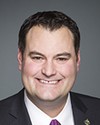First of all, I'd like to thank you all for taking the time to do this important study. It's obvious that a gap needs to be filled, so thank you for taking the time to do this.
On January 18, 2016, I was chosen to be part of a 14-person jury in a murder and abuse trial of a four-year-old and a two-year-old, little girls.
I'll start with the selection process. There were hundreds of people in a room. Everyone was very nervous and not wanting to be selected, with things going on in life and being busy at work and having to be away from things. We didn't know what trial it was going to be until we got there, and it became very apparent that people really didn't want to be part of this jury for the obvious reason of it being about children.
The jury selection took about a morning. We were told right about lunchtime that the trial would start at approximately 1:30 that afternoon, so we had about an hour and a half over lunchtime to get affairs in order and be back at the courthouse, which is not an easy thing to do.
Our trial was relatively short, three weeks in duration. As with all trials, there were lots of very qualified and expert witnesses, police officers, DNA people, forensic pathologists, doctors, police personnel, things like that. I tried to take part of that as an opportunity to learn more about what these people do outside of what we see on TV, on shows, on CSI and things like that, and what actually goes on. But it doesn't take long to understand that what they're going to apply their expertise and knowledge to is not going to be easy.
For three weeks, we heard testimony and were shown photographs of the injuries to two little girls, the stories were told of what and how it happened and near the end, autopsy photos of a four-year-old girl. I don't think any of the 14 people in that jury box would be particularly ready to see those kinds of images.
There were 14 of us from every walk of life, from the unemployed to educated professionals, an 18-year-old girl, a 74-year-old grandmother, parents, non-parents alike, so in a way it was a nice cross-section of society but you also had many people in there who might not have been ready for what they were about to see and might not, at the conclusion of a trial, be able to access services, which is part of what we're here to talk about today.
I'm a teacher in Regina. I've been a teacher for 18 years. I'm now a principal of an elementary school. I think part of this process was difficult for me in that working with children every day over 18 years, I've worked with thousands of families. We see lots of kids maybe have some tough days sometimes, but to have to see what these people subjected these children to was particularly hard for someone who tries their best to make kids' day every day, so that was particularly difficult.
I mentioned the trial was three weeks away from work and things like that. It impacts family life during those three weeks, and not just you but your spouse and your family. It is substantially longer than that when you come out of a trial and you're trying to get your bearings again.
For me, I wanted to go back to work and be back with kids who were well and healthy and happy. I should never have been there. It was a waste of a week, and then we had a spring break. During that spring break, I finally took the advice of the people around me to seek counselling.
Through that counselling, one of the things I talked about was.... The trial ended late on a Friday. I mentioned 14 jurors. We were told 14 jurors so that if anybody dropped out, there would still be 12 to make decisions. All 14 were there at the end, and they needed to pull two jurors out of the deliberations.
Unfortunately—I say “unfortunately” purposefully—I was one of those who were pulled out and not allowed to make those decisions. That was extremely hard, because after seeing what happened to these little girls, for three weeks, to have no say, to have no part in the decision-making process was very tough. At the start, everybody jokingly said, “I hope I'm the one who gets pulled out,” and I obviously said it as well, but that last day, leaving the courtroom with “Thanks for three weeks. See you later” was exceptionally hard. I found out the verdict via Twitter the next day. To see what happened and be subjected to that, and then not be part of the decision-making process, was one of the most difficult things for me throughout that.
I don't want—and I've never wanted—for this to be something where people feel sorry for me, for people to say, “Poor you, you had to do that.” I believe in our justice system, in that we have juries for a reason. We need good, smart people to make decisions that will affect not only the accused but their families and the law in the future. You need juries to do that, but all along I've said that we need to have mechanisms in place to support people, if they should need it, after a trial.
I sought counselling. After about four appointments with the counsellor, who does a lot of work with first responders—EMTs and police specifically—he diagnosed me with PTSD. After what we had talked about.... I told him what we had seen and things like that. The way I was talking about it and the way I was carrying on daily life, he absolutely felt that this was the case.
It comes up every now and then in certain ways, ways you don't expect. Everyone has a bit of dark humour, so when I am at a family gathering and the baby is crying and someone says, “Just duct-tape him in the crib” or something, I have to leave. When you see what actually happened to children who were duct-taped, it's not a funny thing. That happened on a number of occasions, until people started to realize that they shouldn't be talking about that in that way.
Going back to work, the remaining part of that school year, I did not have a lot of trust in things that were happening with kids. A student would come to school with a bruise on their arm, and it might have been from soccer practice or a basketball game, but immediately I would be angry and questioning whether a parent or a sibling did that, how that bruise came to be, when really it was a very natural thing. Kids fall and scrape their knees. Kids do that all the time, yet I had a lot of distrust in what was going on with those kids.
I'm extremely lucky, and I've said this in a number of forums, privately and in the media. I'm very lucky to have an employer who provides assistance, monetary assistance to people who need counselling or other things. I have an exceptional wife who is brilliant and took a lot on in this process, although that's not her job, so there was stress for her as well in trying to make sure I was well. It takes a toll on a family.
For now, as I say, the issue comes up in different ways, at different times. I have gotten past some of that distrust, yet there are times where, for example, I may be lying in bed, and if my feet cross over, I have to immediately uncross them, because of pictures I've seen. This is now two years out, and those things are still coming up. I can't watch things like CSI, as I mentioned, or even 20/20, and W5, the investigative shows about these kinds of things, because it comes back.
I guess, in the end, what I've always wanted was a way for jurors to get help, should they need it. I understand that not everybody sees these things the same way, and that not everybody reacts to them the same way. There were people at our trial who may have gone back to work the Monday after, and said, “You know what? I'm glad that's over” and life goes on.
But I know there are people who come out of these trials, and it's months or maybe years afterward that they're still struggling with what they've seen and what they've heard. When people have to do jury duty, I think it's an omission to not support them afterward. I don't think it's anything purposeful. I don't think it was anybody deciding that, but I feel this is an opportunity to close that gap and make sure jurors are supported.
I open it up to questions, if anybody should have any.



